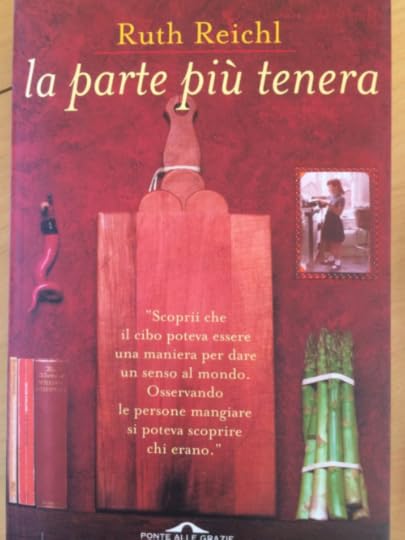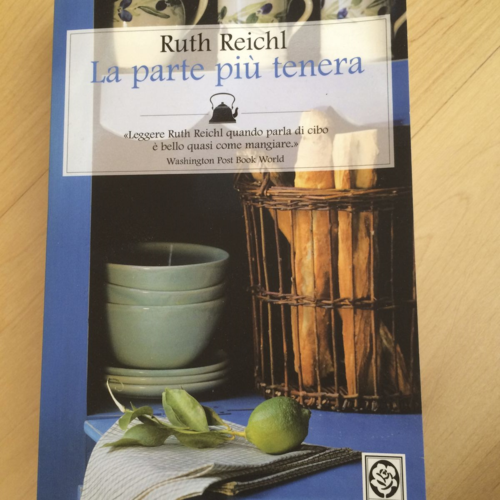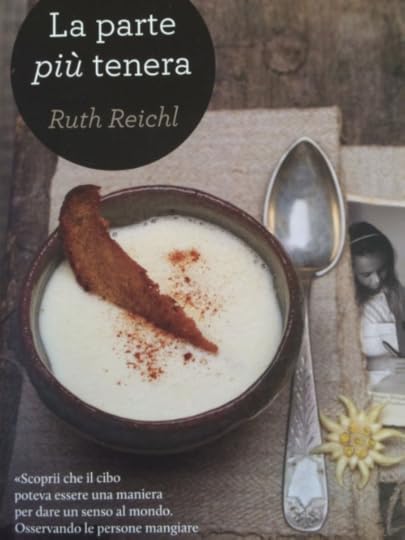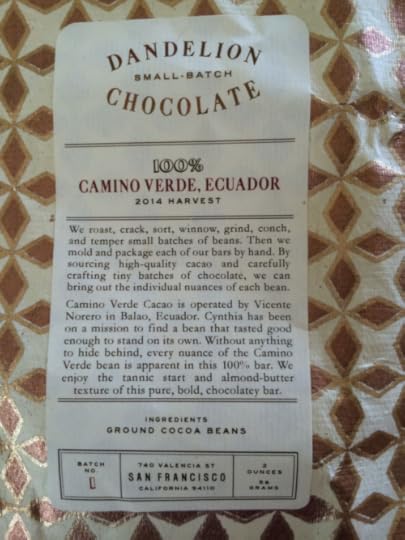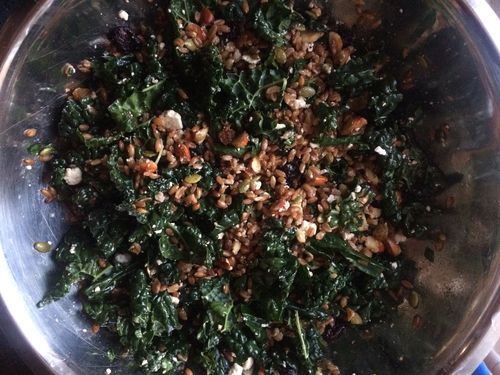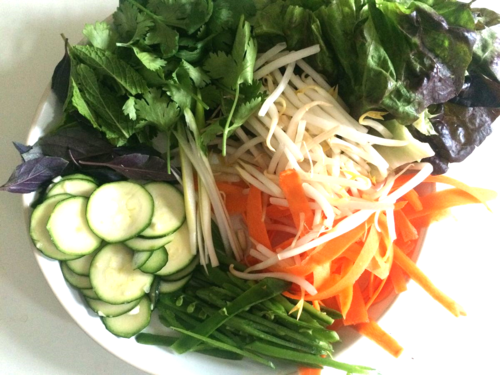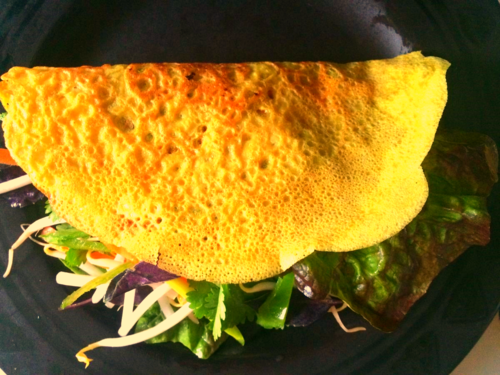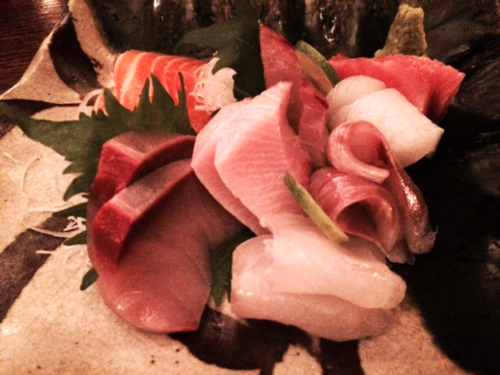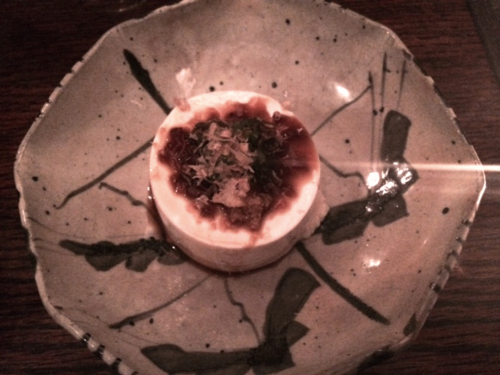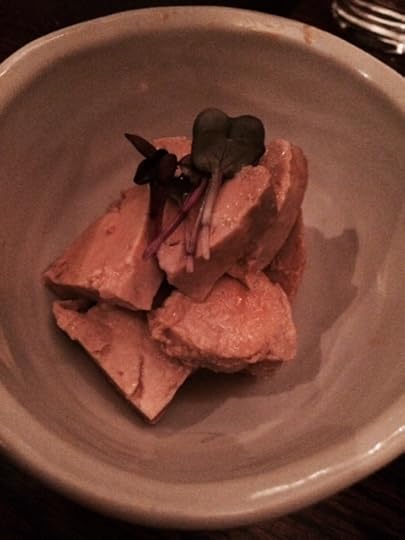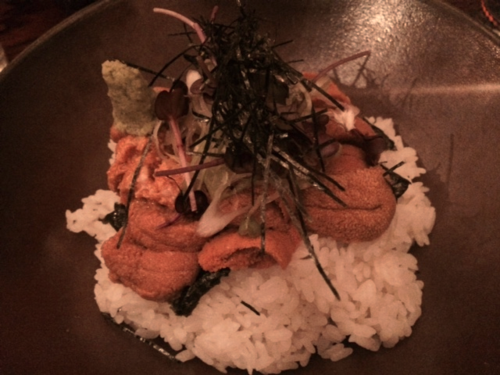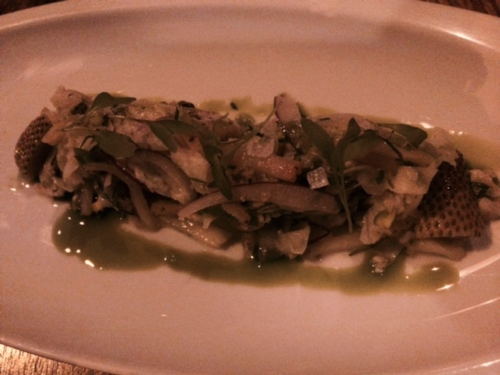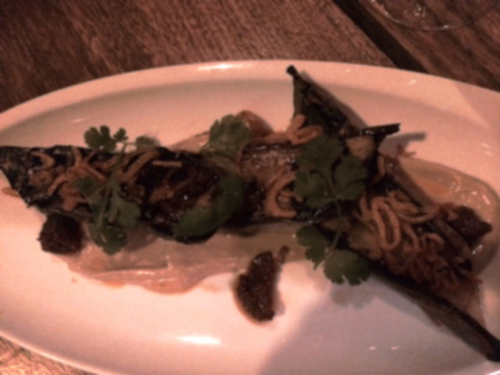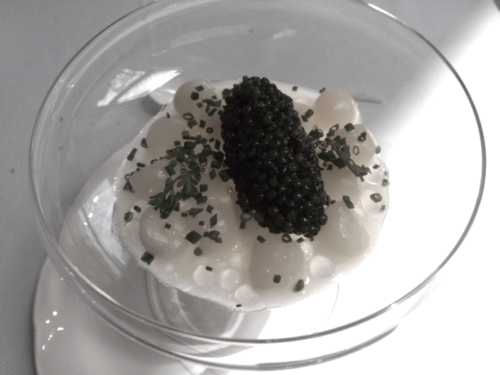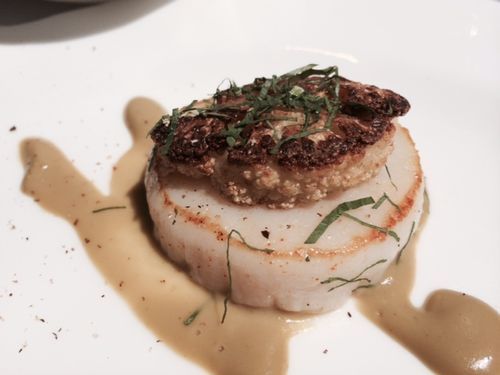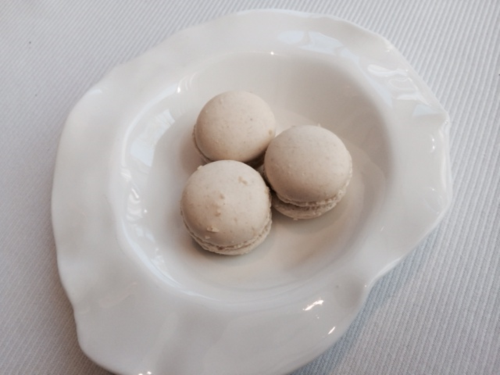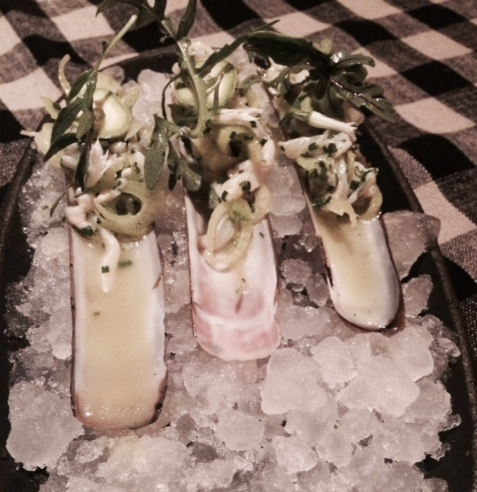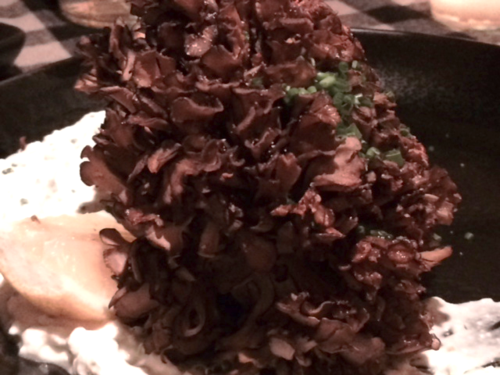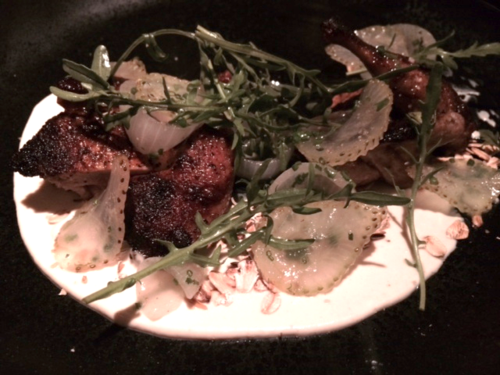Ruth Reichl's Blog, page 10
May 26, 2015
Judging a Book by its Cover
Been thinking a lot about book jackets lately, as we tried to decide what the cover for my new cookbook, My Kitchen Year; 136 Recipes That Saved My Life should look like. (The book will be out at the end of September.)
That sent me to my bookshelf, to the place where I store some of the foreign translations of previous books. I don't have them all; the books are now in twenty-something different languages, but here are some of the more interesting jackets for Tender at the Bone.
I especially like this Taiwanese version; that little girl holding the bowl of food is embossed. But what I like best is that they've used classic food-related paintings for each of the chapter openings. What makes this particularly funny is that so many of them are religious paintings, like Veronese's The Wedding at Cana.

This is the Complex Chinese edition....
This is a different Complex Chinese edition. I kind of love that inside, where they spell out my name in arabic letters, they misspell it, turning me into Ruth Reich.
The Spanish Edition.
This is the Japanese edition.
This is Simplified Chinese.
Three Italian editions.
Tomorrow: a few different takes on Comfort Me With Apples.
May 25, 2015
The Best Brownie Ever

Brownies are the ultimate cheap trick; it takes less than five minutes to throw the classic recipe together, they bake in a flash - and everybody loves them. As far as I���m concerned, there is no such thing as a bad brownie.
But having so few ingredients means that it's remarkably easy to improve the recipe. Replace ordinary ingredients with spectacular ones and you end up with something rich, dark and deep that lingers in your memory long after the last crumb is gone.
But it's not all about ingredients. When a recipe is this simple, technique can also change it enormously. In this version, I double the ingredients in the classic recipe and use a stand mixer to whip the eggs and sugar into a frenzy. The result is a taller, denser brownie with a deep fudge-like interior and a crackling meringue-like top that crunches when you take a bite. (Stir by hand, and you���ll end up with a denser, thinner brownie that some people prefer.)
However you choose to make it, this is a brownie that combines sweetness with the rich sophisticated complexity of chocolate - a little bite of childhood wrapped in a very grown-up package.
Memorable Brownies
2/3 cup (5 ounces) unsalted high-fat butter (like Plugra)
5 ounces unsweetened excellent chocolate (I used Dandelion Camino Verde from Ecuador)
2 cups sugar
2 teaspoons vanilla extract
4 organic eggs
1/2 teaspoon salt
1 cup all-purpose white flour, sifted
To prepare the pan, butter a 9X9 square pan and line the bottom with parchment paper. Butter the bottom again and lightly dust the pan with chocolate or cocoa powder.
Preheat the oven to 400 degrees.
Melt the chocolate and the butter over low heat, stirring constantly until the mixture is smooth and glossy. Stir in the vanilla.
Beat the eggs and salt in a stand mixer. Add the sugar and beat on high for about 10 minutes, until the mixture has turned quite white. Add the chocolate mixture to the eggs, beating on low until just mixed.
Gently stir in the flour until it just disappears.
Pour the batter into the prepared pan, place in the middle of the oven and immediately turn the temperature down to 350 degrees.
Bake for 40 minutes; the brownies will be quite fudgy and a toothpick should come out not quite clean. Cool on a rack.
Invert the pan, remove the parchment paper and invert again onto a cutting surface.
May 23, 2015
A Memorial Day Recipe
When a friend showed up with some beautiful ribs from Iberian pigs that were locally raised and finished on acorns, I began considering how to cook them. Then I remembered one of my favorite Gourmet recipes. It's one that Ian Knauer created for one of our last summer issues. (Ian now has The Farm Cooking School, where he's constantly posting great recipes like the newest one for a sorrel panna cotta.)
Haven't made them yet, but I'm posting the recipe now because the ribs want to marinate for a day or so.
I can hardly wait!
Sweet and Sour Sticky Grilled Baby Back Ribs
8 pounds baby back ribs, preferably from a humanely raised pig
Marinade
12 cloves garlic, minced
2 tablespoons sea salt, divided
3 tablespoons finely chopped fresh rosemary
4 teaspoons cayenne
2 teaspoons smoked paprika
3 tablespoons good quality balsamic vinegar
1 �� tablespoons sea salt
1 �� teaspoons freshly ground black pepper
Glaze
juices from the pans
1 cup balsamic vinegar (inexpensive supermarket kind)
�� cup brown sugar
Mash together the garlic and 1 �� teaspoons salt with the back of a spoon or in a mortar and pestle to make a paste. Mix together the rosemary, brown sugar, balsamic vinegar, cayenne pepper, 1 �� tablespoons salt, and the pepper in a medium bowl, and stir in the garlic paste. Rub the mixture all over the ribs. Remove to a large plastic Ziploc bag or two and refrigerate for 1 to 2 days.
Heat an oven to 300 degrees
Remove the ribs from the refrigerator and let them rest for an hour at room temperature. Place them in two pans in a single layer, add half a cup of water to each pan and cover tightly with aluminum foil. Roast for 3 hours until tender and falling off the bone.
Remove the ribs from the pans and deglaze each pan with a cup of water. Pour the juices into a measuring cup and allow the fat to rise to the top. Skim it off and pour the remaining liquid into a large skillet with the balsamic vinegar and brown sugar. Bring to a boil and reduce the liquid to about one cup, medium high heat, for about 20-30 minutes, stirring occasionally.
Season the ribs with salt and pepper, generously brush the glaze over the ribs, and grill for five minutes to give it a hint of smoke. Brush again just before serving.
May 20, 2015
The Caviar of the Grain Family
Dinner Last Night: Farro
I've been lucky enough to have lunch at The Inn at Pound Ridge by Jean-Georges for the past couple of days. The food has been - no surprise - fantastic. Jean-Georges never stints; after a whole array of appetizers (homemade ricotta with strawberries and olive oil, asparagus with morels, pizza...) we've had fabulous halibut (yesterday's with a saffron sauce), and then no fewer than three delicious desserts. So at dinner, I've wanted to keep it light.
Last night I opened the cupboard and discovered a forgotten bag of farro. It looks like any other grain, but it packs a punch: nutty, robust, and instantly satisfying. To me it's the caviar of the grain family.
But this was not any old farro; this was the finest strain of ancient Italian farro, slowly roasted to coax out even more flavor. As the farro bubbled on the stove, I inhaled the scent of corn. Was there barley in there too? It was wonderfully round and slightly smoky.
And while I���ll admit I was tempted to eat it plain, I decided to do something more. I began pawing through the larder, seeking out crunch and zing.
The result was extremely satisfying. Without further ado, I pass the recipe on to you.
Farro Salad
1 bunch lacinato kale, stemmed and snipped into short strips
1 1/2 cup uncooked farro
2/3 cup hazelnuts or almonds, toasted and roughly chopped
1/2 cup pepitas, toasted
1/3 cup sheep���s milk feta or ricotta salata, crumbled
1/3 cup dried cherries
Dressing:
1 tablespoon harissa
1/3 cup red wine vinegar
1/4 cup olive oil
1/2 teaspoon salt
Big grind of pepper
Pinch of sugar
Bring three cups or so of salted water to a boil. Add the farro, bring to a boil, cover, and set to simmer. Let cook until just past al dente, around 15-20 minutes. Drain and cool until the farro is just warm enough to absorb the dressing without wilting the greens.
Make the dressing. Taste and adjust for seasoning. If you have a low spice tolerance, go easy on the harissa - most varieties can be quite hot.
Throw the kale, nuts, fruit and cheese into a large bowl, and give everything a good toss. Add the cooled farro. Dress to taste; you should have a bit of remaining dressing to use on leftovers.
This keeps well, in the refrigerator, for several days. Add a bit more dressing each time you serve it.
Serves 4.
May 14, 2015
Things I Love: Bitter Sweet
Open a jar of great jam and step into an orchard. Cue sun, wind, and rain.
That's what I thought when a friend brought me this jar of blood orange jam. I took one bite and found myself in Sicily, sun beating down. The jam, made by Fabrizia Lanza (she runs her mother Anna Tasca Lanza's wonderful cooking school in Palermo), has a peculiar sweetness that edges into bitter. The flavor took me right back to the first time I tasted magenta oranges. It was in Sicily,and I was stunned and surprised by the taste.
This jam isn't cheap. On the other hand, I don't know an easier way to travel halfway round the world.
May 12, 2015
Tomorrow at Noon
We still don���t know what it costs.
There are only two women among the 37 chefs.
Still, it���s intriguing.
The Gelinaz shuffle has some of the world���s top chefs swapping not only restaurants, but also homes, lives, and pets. One night only. July 9th.
You buy a ticket, blind. Only when you show up will you find out which chef will be cooking in your restaurant of choice. It would be a kind of Russian Roulette - if the chefs were not so great. But as it is, I don't think you can possibly lose.
I, for one, will be checking in tomorrow at noon, when tickets go one sale. (6 PM Central European Standard Time.)
Hopeful. And excited.
These are the participating chefs:
Danny Bowien, Mission Chinese Food, New York ��� USA
Sean Gray, Momofuku Ko, New York ��� USA
Sean Brock, McCrady's, Charleston ��� USA
David Kinch, Manresa, Los Gatos ��� USA
Daniel Patterson, Coi, San Francisco ��� USA
Dominique Crenn, Atelier Crenn, San Francisco ��� USA
Carlo Mirarchi, Blanca, New York ��� USA
Blaine Wetzel, Willow's Inn, Lummi Island ��� USA
Colombe Saint-Pierre, Chez Saint-Pierre, Le Bic ��� Canada
Claude Bosi, Hibiscus ��� England
Magnus Nilsson, Faviken, J��rpen ��� Sweden
Peter Nilsson, Spritmuseum, Stockholm ��� Sweden
Ren�� Redzepi, Noma, Copenhagen ��� Denmark
Paul Cunningham, Henne Kirkeby Kro, Henne ��� Denmark
Kobe Desramaults, In De Wulf, Dranouter ��� Belgium
Mehmet Gurs, Mikla, Istanbul ��� Turkey
Yoshihiro Narisawa, Narisawa, Tokyo ��� Japan
David Thompson, Nahm, Bangkok ���; Thailand
Ben Shewry, Attica, Melbourne ��� Australia
Jock Zonfrillo, Orana, Adelaide ��� Australia
Bertrand Grebaut, Septime, Paris ��� France
Alain Ducasse, La Plaza Athenee, Paris ��� France
Yannick Alleno, Le Doyen, Paris ��� France
Inaki Alzpitarte, Le Cheateaubriand, Paris ��� France
Mauro Colagreco, Mirazur, Menton ��� France
Alexandre Gauthier, La Grenouillere, Montreuil/Mer ��� France
Ana Ros, Hisa Franko, Kobarid ��� Slovenia
Davide Scabin, Combal Zero, Rivoli ��� Italy
Fulvio Pierangelini, Hotel de Russie, Rome ��� Italy
Riccardo Camanini, Lido 84, Gardone Riviera ��� Italy
Massimo Bottura, La Francescana, Moderna ��� Italy
Massilmillano Alajmo, La Calandre, Venice ��� Italy
Andoni Luis Aduriz, Mugaritz, San Sebastian ��� Spain
Albert Adria, Pakta, Barcelona ��� Spain
Alex Atala, D.O.M., San Paolo ��� Brazil
Rodolfo Guzman, Borago, Santiago ��� Chile
Virgillo Martinez, Central, Lima ��� Peru
May 11, 2015
A Salad to Eat with your Fingers
Banh Xeo
Southeast Asians boldly embrace the raw vegetable. A perfect salad roll, for example, is a challenge to the notion that vegetables require fat or fire to make them special.
That's why this Ottolenghi spin on banh xeo - the Vietnamese crepe often filled with shrimp and pork - caught my eye. It���s essentially just a bunch of garden variety vegetables rolled into a coconut-rice crepe.
But those crepes! The moment the batter hit the heat it became suffused with color, a riot of marigold spreading across the pan. Then the aroma kicked in, filling the kitchen with luxurious tropical scents. Snatched hot from the pan and folded around crisply shredded vegetables and herbs, it made a perfect lunch.
Note: If you���d like these to be truly vegetarian, use Ottolenghi���s dipping sauce recipe. I found it a bit sweet. Nuoc cham, on the other hand? Perfection.
Almost-Vegetarian Banh Xeo
Slightly modified from Ottolenghi's Plenty
Crepes
1 small egg
1 teaspoon turmeric
1/2 teaspoon salt
1 1/3 cup rice flour
One 400ml can coconut milk
Vegetable oil
Vegetable filling:
1 large carrot, shredded
2 green onions
Snow peas, sliced into matchsticks
Cilantro
Basil, ideally Thai
Mint
1 green chile
Bean sprouts
Red-leaf lettuce
Sesame oil
Nu0c Cham:
1 part sugar
1 part rice vinegar
2 parts fish sauce
6 parts water
Chiles
Make the nuoc cham by mixing all the ingredients together. Add chiles to taste and set aside.
Now make the batter, whisking the ingredients together, doing your best to smooth it out. The batter should be thin; if it's not, add a splash of water.
Heat a large skillet and toss in a teaspoon of oil. When it becomes glossy, pour in a medium-sized ladle of batter and swirl the pan around until it spreads into a large, thin crepe. Allow it to cook, on medium heat, about 2 minutes, until the bottom has browned. Flip gently and cook a couple minutes more. Be easy; these are slightly more temperamental than your ordinary wheat crepe.
Repeat with the rest of the batter- you should get 4 or 5 crepes - and set aside.
Use a peeler to make carrot curls. Cut everything else into matchsticks. Arrange the herbs and vegetables attractively on one plate and the crepes on another. Give each person an individual little dish of nuoc cham, and allow them to stuff their own crepes, drizzle on a bit of sesame oil, dip their banh xeo into the sauce - and dream of Vietnam.
This will serve two to four people, depending on their degree of hunger.
May 8, 2015
Tokyo in Manhattan
The most elegant Japanese lady (and I use that word advisedly) urged me to try Donguri on the upper east side. It's not a part of town I often eat in, and last night, looking for a place near hospital row I suddenly remembered how much I liked the last meal I had there..
It's an odd restaurant for New York. The small room is spare without being modern, and it lacks a single spark of chic. Looking around, the word "dowdy" comes to mind.
But there is nothing frumpy about the food. The menu is small, prices high. But everything they serve is seasonal, considered, and of extremely high quality. It made me think of a few small restaurants I've visited in Japan.
To start, a lovely little round of homemade tofu. Creamy. Cool. As spare and unapologetically itself as the restaurant itself.
And ankimo - monkfish liver - the foie gras of the sea. Chefs often try to disguise the faint fishiness of the liver, concentrating on the smooth luxurious texture. This ankimo is as suave as any I've eaten - but it revels in its piscine nature. No disguise here.
Next came that sashimi plate at the top. Totally lovely. And finally what was, for me, the piece de resistence: donburi of sea urchin and yama imo, the wonderful mountain potato. It's a tangle of textures - smooth, slippery, a bit of bite - and extremely opulent flavors. This is not a dish you'll find very often in New York - but then Donguri does its best to forget what is waiting just outside the door.
May 6, 2015
Ramp It Up
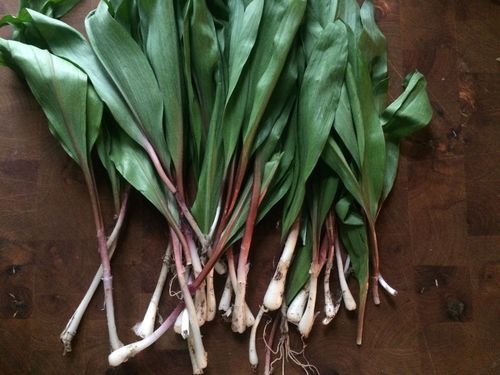
Ramps are the first green vegetable to emerge from the ground each year, nudging aside dried layers of last fall’s leaves. This past weekend, when they appeared, the first swatch of green in our relentlessly brown landscape, the mere sight of them made me happy.
Yesterday, walking in the woods, I literally fell into a patch of ramps. All at once I saw them everywhere, whole clusters dotting the slope of the hill. I pulled out my penknife and dug little moats around each bulb, willing them to pop off their roots. (It's important to leave the roots behind so the ramps return next year.) Before I knew it, I had gathered dinner.
But what to do with them? Standing in the kitchen, washing ramps, I considered the usual suspects. Pasta. Pizza. Pesto. For an extremely versatile vegetable, ramps are too often relegated to the same old recipes. Then I remembered the first time I ever tasted ramps. It was in the Ozarks, in the seventies; we ate them simply fried in bacon fat until they had caramelized into something surprisingly decadent. That! I thought. I'll make that.
I used guanciale instead of bacon. Then I added a couple of fried eggs and a thick slab of toast. It made a lovely- and almost free - dinner for two.
Ramps with Guanciale Lardons
1/2 pound ramps, cleaned
Dash olive oil
1-2 ounces guanciale
Salt and pepper to taste
2 Eggs
Clean the ramps well, trimming off the parts clinging tenaciously to the dirt they grew in. If yours have roots, remove them. Separate the bulbs from the leaves.
Slice the guanciale into thin pieces, no larger than a fingernail. Heat a pan over medium-low heat, add a splash of olive oil and toss in the guanciale. The goal is to render the fat from the jowl evenly without allowing it to crisp or brown; what you want is the rich nutty flavor of the pork without the taste of char. If you sense your guanciale is beginning to brown, cool the pan with a splash of water. It should take about 6 minutes to render the fat, moving it about the pan from time to time.
Remove the guanciale from the pan, leaving a teaspoon or so of that delicious fat behind. Turn up the heat and add the ramp bulbs. When they become translucent, in a minute or so, add the leaves. Let them dance about the pan a bit, and just before everything begins to wilt, remove the ramps to two plates, making a little nest of each portion.
Add a bit more fat and fry two eggs in the same pan. Sprinkle with salt and pepper, and gently place an egg on each ramp nest.
Savor this slowly, knowing that this is a fleeting flavor. Ramps will soon be gone, and they won't return until next spring.
May 1, 2015
24 hours: Three Great Meals
New York
My friend Nancy blew into town yesterday, raving about the food she ate in Israel. In her words, "every meal was jump up and down delicious." I've never heard her so excited.
It seemed like the perfect time for a trip to Bar Bolonat.
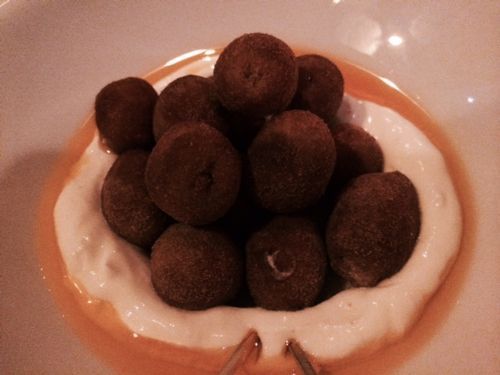
I was captured with the first bite: fried olives with labneh. Utterly irresistible. Crisp, salty, smooth, rich - all in a single bite. Why have I never had these before?
I loved the fluke ceviche too, a tangle of flavors that went swirling through my mouth. The fish was smooth and plump, the green strawberries added an acid note, the pistachios a frizz of nuttiness.
Eggplant: how did they coax such sweetness out of the vegetable? Each little length of eggplant was a soft, sweet pillow.
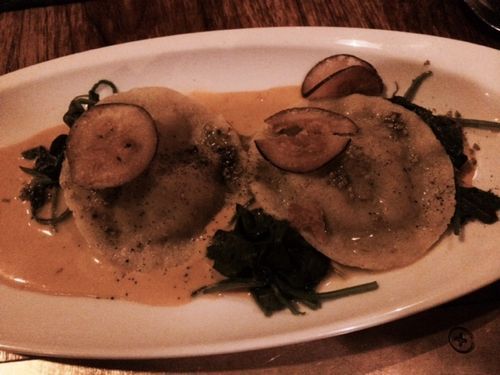
These ravioli are filled with eggplant in an entirely different mood: smokey and mysterious, it's the yang to the other's yin. These two dishes confirm that eggplant truly is the chameleon of the vegetable world.
But my favorite dish was this Yemenite shrimp curry, perfumed with coconut and accompanied by a sexy little round of malawah, the seductive Yemeni bread.
Bar Bolonat is dark, casual and clamorous. Lunch the next day could not have offered a greater contrast. To me Jean Georges is the loveliest place to lunch in New York, a calm airy light-filled oasis that is just loud enough to feel lively while allowing you the luxury of quiet conversation. I can't think of anywhere I'd rather be. Especially when lunch starts with this caviar confection.
Potatoes. Tapioca. Chives. And mounds of caviar. Pure, irresistible luxury.
We also had one of my favorite dishes, which has been on the restaurant's menu since day one. Take a bite and you understand why. Caramelized cauliflower. Scallop. Caper-raisin emulsion. Heaven.
The meal stretched on, each dish an essay on the power of great cuisine when you're in a restaurant run by a talented chef at the top of his game. At $48 for a prix fixe lunch that ends with tiny macaroons, a plate of chocolates and hand-made marshmallows, it's hard to think of a more effective way to feel happy, pampered, special.
But of everything I ate in this twenty-four hour odyssey of eating, this dish was my favorite.
And it's at my favorite new restaurant. Upland is the perfect New York place of the moment. Urban. Lively. Relaxed. Casual. And the food is fantastic. The razor clams were topped with new green almonds (served as I've never had them before, sliced horizontally, fuzzy shell and all), green onions and lemon. In my opinion the long lithe clams have never tasted so delicious.
We also had this impressive construction of burrata, cured tuna and blood oranges. The ingredients played beautifully together, creating wonderful harmonies in the mouth.
Then there was this mushroom, which was like nothing I've had before. This ziggurat of hen of the woods mushrooms resembled a sculpture more than a food. It had been crisped, then plonked onto a bed of cloumage, a simple, creamy curd of a cheese. I found myself dreamily pulling off one little section after another, mesmerized by the texture.
These quail, with their cool bits of onion and green strawberries were also a joy to pick up and eat with your fingers. A fine end to a truly impressive meal.
Three restaurants. Three moods. Three different ways to enjoy spring in the city.
Ruth Reichl's Blog
- Ruth Reichl's profile
- 2980 followers







